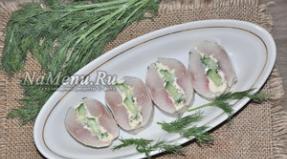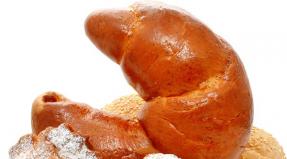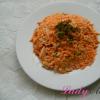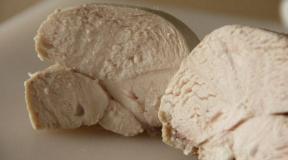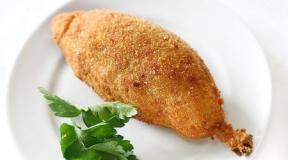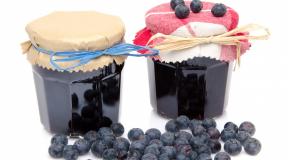Big green fruit. The most exotic fruits
Fruits and vegetables in Thailand are very diverse. Below we have collected for you what you should definitely try while in the land of smiles.
Fruit in Thailand
1. Durian
Durian (Thai name - durian) is the undisputed leader of our list. The fruit is pale green-yellow in color with a shell-like skin. Weight from 2 to 5 kg. Durian has a very bad smell and excellent sweet and creamy taste. Durian is eaten raw, while the seeds are roasted and eaten instead of nuts. Keeping at home or in a hotel, as well as transporting, is not recommended due to the smell. In many hotels, hospitals, shopping centers and other public places, you can find special signs reminding you that it is forbidden to bring durian into the room. The Thais themselves speak of durian as "a fruit with the taste of heaven and the smell of hell."

Do not try durian - vacation in vain))
2. Mango
Mango (Thai name - mamuang) - outwardly yellow, green or reddish oblong fruit, outwardly a bit like a melon. Inside, juicy yellow-orange or green flesh with a sweet and sour taste.

In my opinion, the most delicious mango is green on the outside and yellow on the inside.
3. Dragon fruit
Pitaya or pitahaya ("dragon fruit", dragon's eye) (Thai name - geow mangon). Bright pink or yellow fruits with sparse green scales. Inside, white or red flesh with small black seeds.

4. Guava
Guava (Thai name - farang) - fruits of light green color, outwardly resemble an apple. Rough skin outside. The flesh is white or red, crisp like an apple, with many small seeds.

5. Papaya
Papaya (papaya) (Thai name - malakor) - pear-shaped fruits, green or yellow. The flesh is orange or bright pink. Papaya is eaten both as a vegetable and as a fruit, depending on the degree of ripeness. Thais love to cook their famous “papaya salad” from papaya.

6. Mangosteen
Mangosteen (mangosteen) (Thai name - mangkhud) - a small fruit that looks like an apple with a brown or purple skin. Sweet. Tastes like grapefruit.

7. Lychee
Lychee (Thai name - linchi) - fruits the size of a small plum, with a scaly pink peel. Inside white pulp, which is eaten, and an inedible bone. It tastes like grapes.

8. Sapodilla
Sapodilla (Thai name - la moot) - a yellow-brown fruit, similar to kiwi. Crispy flesh with a creamy caramel flavor and a few hard pits. It tastes like persimmon.

9. Passion fruit
Passion fruit is a purplish-purple or golden fruit, about the size of a small grapefruit. Under the peel are the bones in a juicy sweet shell. It turns out a very tasty cocktail: soda, passion fruit and sugar syrup.))

10. Longan
Longan (Thai name - lamyai) - small fruits of light brown color, resembling walnuts in appearance. Inside is a transparent white pulp and a hard bone.

11. Jackfruit
Jackfruit (Indian breadfruit, eve) is a large fruit with thick, spiky, yellow-green skin. It looks like a durian, but its "thorns" are smaller. The pulp is yellow, sweet, with an unusual smell and taste of a Duchesse pear. The segments are separated from each other and sold in bags. The ripened pulp is eaten fresh, the unripened is cooked. Jackfruit is mixed with other fruits, added to ice cream, coconut milk. The seeds are edible when boiled.

12. Pineapple
Pineapple (Thai name - sapa rot). Thailand's pineapples are considered among the best in the world. There are about 80 varieties of this fruit. Its taste is rich - from sweet and sour to honey. The smell of ripe pineapple is pleasant and slightly sweet. When choosing a pineapple, pay attention to its texture: it should be slightly crumpled under your fingers, but not too soft or, conversely, too hard. In Thailand, mini pineapple, or as it is called "royal pineapple", is also very popular.

 13. Coconut
13. Coconut
Coconut (Thai name - ma phrao). Season: all year round. If not for these fruits, Thai cuisine would be just a combination of Chinese and Indian. They are added to rice and eaten fresh. Most soups are cooked with coconut milk. Coconuts in syrup are offered as a dessert. The markets sell coconut milk right in the fruit. Be prepared for the fact that coconuts in Thailand are not the coconuts we are used to seeing in bounty ads. They are green and big. But, there is another type - small light brown.

14. Langsat
Langsat (Thai name - lang sat). Season: July to October. This fruit is almost unknown outside the country, but is very popular in Thailand itself. Its grayish flesh has both a sweet and sour taste. Langsat seeds are bitter, so the fruit should be eaten with care. Do not confuse with longan.

15. Pomelo
Pomelo (Thai name - som oh). Season: from August to November. It tastes like grapefruit, but more sweet than sour. In addition, the pomelo is much larger in size. The flesh is reddish, pale yellow and orange.

16. Rambutan
Rambutan (Thai name - ngaw). Season: all year round, peak - from May to September. One of the most noticeable and delicious exclusively Thai fruits. Bright red fruits with pale green bristles taste vaguely reminiscent of grapes, only sweeter. Rambutan grows in the central and southern provinces (Chanthaburi, Pattaya region, Suratthani).

17. Rose apple
Rose apple (Thai name - chom poo). Season: all year round. There are two varieties of this fruit: one is really pink, the other is green. To taste, the fruits are similar to ordinary apples, only a little more sour. Most beautiful rose apples appear on the markets in the cool season - from November to March.

18. Salak
salak, snake fruit(Thai name - la kham). The scaly fruits are burgundy-brown in color, the shape is oval and slightly elongated, reminiscent of a drop of water. The peel is thin and fairly easy to remove, but when peeling the fruit, you need to be careful: it is covered with small soft spikes. The flesh of the herring is yellowish-white.

19. sugar apple
Sugar apple (Thai name - noi naa). Season: June to September. Under the bumpy green skin lies a sweet and fragrant milky flesh. If the fruit is ripe enough, you can eat it with a spoon. By the way, the basis of the special ice cream served in Thai restaurants is the sugar apple. The fruit loves a hot and humid climate, so it is grown mainly in the south of the country.

20. Carambola
Carambola (Thai name - ma feung). Season: October to December. Fruits are yellow or green, oblong. Cut across have the shape of a five-pointed star. Because of this, they have a second name - star fruit, or " star fruit". Ripe fruits are very juicy. The taste is pleasant, with floral notes, not very sweet. Unripe fruits are quite sour. They contain a lot of vitamin C. The fruit is mainly used for making salads, sauces, juices and soft drinks.

21. Tamarind
Tamarind (Thai name - makham thad). Season: December to March. Tamarind is a sour fruit, but it grows in Thailand sweet variety. Thais usually boil the fruit in water to get a refreshing drink.

22. Watermelon
Watermelon (Thai name - Taeng Mo). Season: all year round. Peak season: October-March. Appearance: Watermelons are small in size, with red or yellow flesh. Yellow ones are more expensive, because in Thailand it is the color of wealth. Taste: Sugar-sweet common to watermelon, refreshing in both varieties. Significantly sweeter than Astrakhan. Consumption: Necks, smoothies and fresh watermelon juice are popular. Used for figured fruit carving.

23. Banana
Banana - (Thai name - Kluai). Season: all year round. Appearance: yellow or green. Taste: very sweet, the smaller the size and thinner the skin, the tastier, but these are not stored. Long ones are stored better, they cost more. Very nutritious, they are eaten unripe with spices, semi-ripe dried in the sun, ripened deep-fried, boiled in coconut milk or syrup, the flowers are used in cooking various dishes.

24. Mandarin
Mandarin (Thai name - Som). Season: all year round. Peak season September-February. Appearance. Smaller than European varieties, with a thinner, greenish-yellow skin. Taste: sweet with slight sourness, very juicy. Compared to European varieties, not so bright taste. Consumption: In Thailand, they are mainly juiced and sold everywhere on stalls on the streets.

Fruits in Thailand by seasons.

Almost two-thirds of the list of the most amazing tropical fruits on the planet is occupied by the fruits of Thailand. The rating includes little known fruit with unique qualities and properties.
In this fruit row, one could safely add some valuable and interesting fruits Thailand, for example, the list did not include durian - a very capricious and ambiguous fruit or jackfruit - the largest fruit in the world that gave its taste and aroma chewing gum Juicefruit.
The list includes the least known, because the mysterious and amazing tropical fruits, the taste of which, in appearance, is very difficult to predict.

Its historical homeland is tropical America. It is widely grown in Pakistan, India and the Philippines.
Sugar apple is a permanent resident of the trading counters in Thailand. The fruit looks like a huge cone, about 10 cm in diameter. Under the tough, always green skin, there is a fragrant tender pulp with several seeds inside.
Uniqueness - sugar apple has delicate aroma and custard flavor. After cutting it in half, pour coconut milk and refrigerate. It turns out excellent ice cream, exclusively from natural ingredients.

The evergreen sapodilla tree considers the countries of Southeast Asia, West Africa and South America to be its home. Found in Florida and Hawaii.
In fact, sapodila is a berry that can be up to 20 cm in diameter. A dense skin with soft orange or dark yellow flesh inside. It has from one to four large bones. Very tasty and sweet fruit Thailand.
18 Cream apple

A cream apple is very similar to a sugar apple in both shape and color.
Many consider this one fruit with different varieties, connoisseurs say that these are two completely different tropical fruits, and here's why:
Cherimoya fruits round shape and have a peel of three types from sharp, pronounced bumps to a smoother peel of a light yellow or reddish color.
The flesh of the cream apple is white, juicy, reminiscent of cream, combines the taste of banana, passion fruit, papaya and pineapple. One of the most delicious fruits in the world.

Santol is one of the favorite fruits of Thailand among local children, in Southeast Asia it is called "fruit on a stick".
Ranging in size from orange to pamelo and similar in appearance to the popular citrus, but with thicker, darker colored skins.
Inside are several sweet and sour white segments with a pleasant aroma. Santol bones have sharp edges in autumn, so they should not be swallowed in any case.

The fruits of this tropical fruit can be found in the mountainous regions of South America.
The cocoon grows on a small shrub and can miraculously grow from fruit seeds in 9 months and it will take another 2 months for the fruits of the new bush to ripen.
The fruit is a red, orange or yellow berry, similar in appearance to a tomato, and is said to taste like a mixture of tomato and lemon.

A huge tree of the mulberry family, grows in India, the Philippines, Thailand and all the islands of Southeast Asia.
Ripe fruits taste soft and sweet, similar to bananas, unripe hard and starchy.
From unripe fruits they prepare various dishes and, when cooked, the fruits acquire the taste of freshly baked bread. Therefore, one of the versions of the name is breadfruit.
Another version is less romantic. Breadfruit is nutritious and is the main dish for low-income residents of India and some countries and islands of Southeast Asia.

Two more tropical top fruits of Thailand, included in the rating of "the most amazing fruits of the planet." Langsat and longan are completely similar fruits in appearance to berries that grow throughout Southeast Asia.

The size of walnuts. Langsat berries grow, as if sticking around a twig, like sea buckthorn.
Inside the langsat fruit are five segments, some have bitter seeds inside that taste like pamelo. Pamelo in miniature.
The rind of langsat contains a latex substance that holds the flesh together, making it harder to peel than longan, which does not contain latex.

Each fruit grows on its own branch, attaching to a larger branch, so it is sold in bunches. Has one bone in the center.
Longan is sweet and tastes like grapes.
They are canned, dried and dried like raisins. Thailand is the world's largest producer of langsat. It is cultivated and new varieties are being developed. Langsat grown in Thailand is the most delicious in the world.
13 African pears

African pears are the fruit of an evergreen tree found in the tropical rainforests of Africa. Sappho grows as far south as Angola and as far north as Nigeria.
Fruits are oblong, dark blue to purple up to 14 cm long with pale green flesh inside. These are fatty fruits, and according to scientists, African pears can end hunger in Africa.
The fruit contains 48% essential fatty acids, amino acids, vitamins and triglycerides.
It is estimated that one hectare of an African pear plantation can produce 7-8 tons of oil, with all parts of the plant being usable.

A very strange plant from the southeastern part of Brazil.
What makes it amazing is that fruits grow from its trunk.
Initially, yellowish-white flowers appear all over the trunk and at the base of the branches, then they grow into fruits 3-4 cm in diameter. Under the dark purple skin is yellow flesh with 1-4 black seeds.
Brazilian grapes are sweet. They are eaten fresh, wine and liquor are prepared.
The fruits do not persist for a long time, 3-4 days after harvest, they begin to ferment.

The most popular exotic fruit of Thailand and Southeast Asia, this is his homeland.
The unusual peel of the fruit adds exoticism to the fruit, the consistency of the pulp is like that of a grape with a stone inside. The taste of rambutans is sweet and juicy.
Rambutan fruits are oval in shape and about 3-6 cm in diameter. It is not difficult to peel if you cut the peel in a circle.

Noni, the fruit of Thailand, is otherwise known by various names around the world - great moringa, cheese tree, Indian mulberry, dog dumplings and tempo.
All coffee trees are related to him, all of Southeast Asia and Australia are his home.
The tree bears fruit all year round. Its fruits have a pungent odor. Despite the strong and slightly pleasant smell, the fruits are rich in vitamins, proteins, iron, calcium and high in fiber.

Noni is added to stews or eaten raw with salt. Popular and probably very useful noni juice.
Tones, fights overweight and helps, as the manufacturers say, from many ailments. In many Pacific Islands, noni is a staple food and medicinal plant.

Marula grows on deciduous trees in South and East Africa.
The trees spread across the continent, following the roads of the Bantu people, for whom it is the main source of food.
The Bantu people planted trees all along their path. Green fruits turn yellow and become ripe. Marula has white, juicy flesh with an excellent aroma.
As they fall from the trees, no fruits begin to ferment and provide a little alcoholic pleasure to the elephants and baboons.
Marula is used to make the popular Amarula liqueur, which is sold at all Duty Free airports around the world.

Homeland of beautiful berries - the west coast North America stretching halfway from Alaska to California. They are found in moist forests and form dense thickets. The berries are similar to raspberries, but bright orange, salmon. They are sweet when eaten raw. Juice, wine, jams and marmalade are prepared from them.

Salak, also known as snake fruit.
It comes from a species of palm trees native to Indonesia.
These fruits grow at the base of palm leaves and get their name from their red-brown scaly skin.
It is easily removed and inside there are three white, sweet segments, each of them has a black inedible bone. The fruits have sweet and sour taste and apple-like texture.
6 Bale

Amazing tropical fruit bale, it can be found in all shops and souvenir shops in Thailand.
Bale is surrounded by many ancient legends. The fruit has many names - golden apple, stone apple.
The peel of the bale is colored yellow, green, gray and is so strong that you need to use a hammer or a saw to open the fruit.

Inside, fragrant yellow flesh with fluffy seeds. The pulp can be eaten fresh or dried.
Sherbet is made from the juice of fresh fruits - water, sugar and lemon juice are added to the hole in the peel.
From the largest fruit, you can get 6 liters of sherbet. An amazing fruit that grows as a dried fruit.

Dragonfruit or dragon fruit this is a cactus fruit - a beautiful and bright representative of the amazing fruits of the planet and a popular fruit of Thailand, which can be tasted in the Land of Smiles all year round.
It grows throughout Asia, Australia, North and South America, although originally, its homeland is Mexico.
There are two main types of dragon fruit - sour, which is popular in America, and sweet, popular in Asia.
Dragonfruit has three varieties that differ in color: red, yellow, and Costa Rica. "Red" fruits - with bright crimson skin and light, white flesh, yellow pitahaya with bright yellow skin and light, creamy flesh, Costa Rica pitaya with purple skin and purple flesh.
Dragonfruits are juicy, slightly sweet with a slight pleasant aroma.
1 Miracle Berries

A very strange berry native to West Africa.
What makes the fruit weird, wonderful and wonderful is miraculin (a sugar substitute) which is found in high amounts in the fruit combined with a glycoprotein.
The fruit itself does not contain much sugar, its taste is only slightly sweet, but an hour after eating the wonderful berries, when the glycoprotein acts on the taste buds of the tongue, the taste of any product is distorted, turning into sweetness.
For a practical study, you can eat a lemon after the wonderful berries to taste the sweet syrup.
Certain reasons for this phenomenon are not fully understood, it would seem how miraculin can distort the perception of receptors on the tongue so that they perceive acid for sweetness.
In the 1970s, attempts were made to sell wonderful fruits as dietary products in the fight against diabetes and obesity.
But they failed when the FDA declared them food additive under pressure from the sugar companies, who had foreseen the losses.
In the past two years, the berry has been gaining popularity again, becoming a guest star at many parties in the United States.
Guests are offered to taste wonderful sweet berries first, and then all kinds of common products to experience new taste sensations with every bite.
An integral part of any trip is foreign cuisine, special dishes and unusual tastings. And if you choose this type of tourism as gastronomic, then atypical treats are literally a must. In particular, we are talking about fruits. But not everyone, going somewhere to warm lands, is well aware of exotic tropical fruits and their names. We will try to introduce you to the most interesting desserts foreign world.
Guava is the sister of the Ukrainian pear
Very similar to our pear and slightly sour in taste, guava is a tropical fruit native to Mexico, South America, India, and parts of Southeast Asia. Outwardly, it looks like a 10-14 cm oval of yellow-green color. The fruits ripen on small deciduous shrubs.
Eating stale guava is just as dangerous as eating other fruits. At the very least, you're at risk of indigestion. In addition, unripe guava is quite sour and unpleasant, astringent in taste. When these exotic fruits reach the “necessary condition”, they will become tasty and quite healthy.
Guava is recommended for use in case of intoxication, as well as for weight loss and all kinds of minor inflammatory processes of the gastrointestinal tract. And freshly squeezed guava juice and its seeds have a positive effect on the work of the stomach. You can eat the fruit along with the peel, but we recommend that diabetics be careful with this, as it increases the level of glucose in the body.
Dragon eye - a fruit with an abundance of vitamins
Such exotic name was awarded to an unusual-looking and slightly melon-like fruit. In everyday life, the dragon's eye is called longan, which grows in Thailand on tall 10-meter trees. Lush crowns of trees hide round yellow fruits in their thick. If you remove the peel from them, you will see white flesh inside. It is extremely useful due to the high content of trace elements. In particular, we are talking about organic acids, protein, calcium, copper, zinc, phosphorus, iron and much more.
Thanks to the original sweet taste, the fruit is extremely popular among locals and tourists. It is either peeled and eaten raw, or cooked in rice dishes. Served with stewed cereals and coconut milk. Also, local craftsmen make sauces from longan, and even ice cream. No negative properties of the fruit were noticed, but still overeat dragon eye do not recommend.
Carambola is a star in your plate
Carambola is an extremely popular and well-known fruit not only in Asian countries, but also in Ukraine. Thanks to his unusual look carambola is used as an element of decoration of dishes haute cuisine. Fruit size - large goose egg, the color is yellow, and in the context of carambola it resembles an asterisk.
You can eat both the pulp and the peel. This fruit is useful both raw and fried. It can taste both slightly sour and sweet. Tourists cannot agree on what carambola tastes like, what it looks like. It reminds someone of a plum, someone of a grape, someone of an apple. But everyone unanimously says that the fruit is extremely tasty. The fruit contains sodium, iron, calcium, phosphorus, vitamins of groups B and C. Carambola is either served raw or deep-fried, and can also be boiled in sweet syrup.
Eggplant or mangosteen?
This fruit has several names - mangkut, garcinia, mangosteen and, of course, mangosteen. It grows in South Asia, in Vietnam, Thailand, India. This berry looks like a rounded purple-burgundy eggplant. It weighs up to 200 grams, and when cut it looks like white flesh. The inner part of the fruit is soft, melting and zephyr-like. Very sweet in taste, mangosteen is a fruit that serves as the basis for various jams, desserts, nectars, syrups and juices. Also, the popularity of the fruit is based on the versatility of flavors - culinary experts note echoes of peach, pineapple and lychee in garcinia.
The peel is also popular, which is used in traditional medicine. But we strongly do not recommend eating fruit during pregnancy and breastfeeding. And also in case of illness gastrointestinal tract, kidney and liver.
Sugar apple noina
Another name for the fruit is sugar apple, which is really very sweet. However, the taste is more like late apricot which does not make this treat less popular and tasty. Noina grows in the tropical zone, and is used from roots to fruits. Decoctions and tinctures from leaves, roots and bark help with fever and even dysentery.
When choosing noina on the market, be careful, it is important to buy exactly ripe fruit, otherwise you risk poisoning. Noina should be greenish, heavy in feel and soft to the touch. And, of course, the fruit should smell very good and tasty. When eating the fruit, do not eat the seeds - they are useful only in the field of cosmetology and exclusively in the form of oil.
This prickly cone may not be noticed on the branch, but it is very popular with Asian gourmets. Another name for this tropical delicacy is soursop. It has a sweet and sour taste and contains a lot of useful elements. Researchers massively claim that sirsak is able to treat cancer. V Chinese medicine Dried fruit powders are added to medicines and tablets.
European scientists in the course of research have found that the fetus actually stops the spread of the disease and reduces the activity of cancer cells. Sirsak cannot fully replace chemotherapy, but it can help prevent the disease. But despite pleasant taste and useful properties, do not overdo it with tasting. Excess fruit can lead to intoxication and even hallucinations.
chocolate chicu
Chiku fruit has a second name - sepodilla. It looks like beige or brownish balls, inside - orange pulp and large black oblong bones. Chica is eaten raw, separated from the bitter skin and hard seeds. The fruit has a caramel flavor, and some varieties are coffee and chocolate flavor.
The texture of the chiku is soft and should be quite large. Before use, sepodilla is recommended to be cooled, cut in half or into slices. The pulp can be eaten with a spoon, or just bite off the peel like a watermelon or melon.
Pitahaya - dragon fruit
Unusual, beautiful, bright, called the heart of the dragon, the fruit is widely known to the public. But few people know what it tastes like. Pitahaya looks different depending on the variety. White has pink skin and white flesh, red has pink skin and red flesh, yellow has yellow skin and white flesh respectively. All of them are popular in their own way and unusual in taste, as well as extremely useful. In particular, due to the high content of fiber and antioxidants. Pitahaya is also recommended for diabetics, as the fruit lowers the level of sugar in your blood.
Desserts and juices are prepared from the fruit, and the pulp is added to salads and light dishes. It can be eaten raw by cutting it in half and eating the pulp with a spoon. The peel is beautiful, but not edible. Often "bowls" of fruit peel are used as decoration.
Of the side effects, only an allergic reaction is observed, as well as indigestion when overeating.
exotic fruit lychee
This Chinese plum, which grows in clusters and has a pinkish-reddish color. The fruits are covered with a peel with convex pimples, inside - soft light pulp and a small bone. The taste of lychee is similar to grapes, in texture - to hardened jelly.
You can eat these fruits, they are tasty and memorable. When choosing a plum, be sure to feel the berries themselves, they should not be too soft or darkened. If the lychee is maroon in color, then this means that it has been on sale for a long time and is no longer particularly fresh. Alternatively, you can try dried lychee. Syrups are made from it, jelly is rolled up and even added to ice cream.
The abundance of potassium, magnesium and vitamins of group C helps to strengthen the cardiovascular system. And also Chinese doctors recommend lychee for those who suffer from advanced level cholesterol.
Cucumber melon kiwano
Horned melon occupies one of the leading steps in the list of the most beautiful tropical fruits. Yellow-green prickly peel, as well as green flesh, similar in texture to citrus fruits. This fruit definitely deserves a place both on your plate and on the Instagram feed.
Another variant of the name kivano is horned or Antillean cucumber. It grows in New Zealand, central Africa and California. To taste, the melon has a cucumber-banana-melon flavor, with a slight kiwi flavor. Agree, this is certainly an unforgettable combination!
Do not overdo it with tasting and at the same time remember that, within reasonable limits, the melon enriches the body with vitamins B and C. Cut it in half and eat the pulp right along with the seeds.
Ripe black sapote
Unusual in appearance, but original in taste, the fruit is extremely popular in Central America and Mexico. The size of the ripe fruit reaches ten centimeters in diameter. Inside - sticky, slightly viscous pulp, as well as several large seeds. Sapota's main feature is its chocolate flavor. Really chocolatey!
The skin of the fruit has green color, inside the flesh is black-brown. This fruit is rich in vitamin C and calcium, and it is also very suitable for those who are on a diet, as it contains almost zero fat content.
prickly snake fruit
Another black and strange fruit that protects itself from unwanted hands. The fact is that the fruit is tasty and soft inside, from the outside it is covered with snake skin - a prickly brown-black peel. This is exactly what he is, an unusual herring or snake fruit.
Be careful when peeling the fruit. On small scales it is possible to cut yourself. But the pulp itself contains calcium, phosphorus, iron and beta-carotene.
But do not eat too much herring, despite the pleasant pineapple taste, if you overeat, it can cause an allergic reaction and poisoning.
Jaboticaba tree fruit
This fruit grows directly on the tree, even on the bark. Its main habitat is Brazil. It is here that the fruit is used as an ingredient in desserts, as well as raw materials for liqueurs and wine. Jaboticaba also helps with asthma, dysentery and disorders.
The peculiarity of these black fruits is that they spoil quickly enough. You need to eat the fruit within two to three days after it was plucked. That is why in shops and restaurants in Brazil you can mainly find jamoticaba jams, preserves and syrups.
chocolate creeper
This is truly a waste-free fruit that is used to the fullest. Chocolate creeper or more scientific name akebia is eaten literally all. Pear-shaped fruit is cut in half or a small incision is made. The white, slightly pearly flesh is scooped out with a spoon and served with the seeds as a dessert. And the purple peel is stuffed with meat or seafood, and then baked and served on the table. Even dried fruit leaves are served as a tea or condiment.
The taste of chocolate liana is similar to raspberries, but the smell of chocolate remains here. The flowers also smell like chocolate. fruit tree. Therefore, it is worth taking a walk near the akebia tree during the flowering period to enjoy the aromas.
finger lime
This fruit reminds many people of rolls with red caviar. But in fact, this is lime caviar, which tastes absolutely identical to ordinary lime. Tourists are attracted by the appearance.
The oval dark fruits inside contain reddish and pinkish caviar balls filled with juice. It is the caviar itself that is used in the preparation of desserts and fish and meat dishes. The fruit is remarkable in that it contains many useful, tonic and regenerating enzymes.
But be careful, because overeating can cause allergies. Also, finger lime is not recommended for use by those who suffer from ulcers, pancreatitis, gastritis, colitis and other intestinal diseases.
Melotria rough
The peculiarity of melotria is that it looks like small watermelons. But it tastes more like a sour cucumber with a lemon aftertaste. It grows on climbing shrubs and is a good prevention of cancer.
The skin of the fruit is hard, and the flesh really resembles a cucumber. It is important not to let the melotria oversing, fresh and timely picked fruits are very tasty and healthy. You can also pickle or pickle melotria as regular cucumber. It is pickled that it is most often served in Asian restaurants.
It is recommended to consume this fruit a little every day, as it is useful in losing weight and is perfect for diabetics. But be careful those who suffer from diseases of the cardiovascular system and intestinal tract.
Musical biriba
The fruit looks like a yellow, slightly blackening ball. The peel has scales, while inside the pulp is white, the bones are small and black. The taste of biriba resembles lemon meringue, and it is harvested in the early stages, without waiting for full ripening. She is already ripening in boxes and on the shelves.
Biriba is mostly grown and sold in South America. The main indicator of maturity is a yellow, beginning to blacken peel. If overripe, the flesh will be inedible and bitter.
Ripe fruit is eaten raw, and sometimes juices, syrups and even wine are made from it. Dried fruits are used to make musical instruments!
Miraculous Berries
These berries are similar to barboris, they are red and quite large. They are called miraculous due to the unusual effect on taste buds. After tasting the berries, any food you eat will seem sweet to you. All this is due to the content of glycol-protein. It reduces the sensitivity of receptors responsible for all tastes except sweet. The effect of sweetness lasts up to two hours.
Don't overeat, of course. But some bizarre, miraculously useful and medical properties have not been found. Along with this, miracle berries are good for those who are currently on a diet, it will reduce the sugar intake in your diet.
Tamarillo or tomato?
Despite the fact that tamarillo is a fruit, it is similar in appearance and taste to a tomato. It has a red-orange color of the skin, and a red-burgundy color of the flesh. The bush itself, on which tamarillo grows, also looks like a tomato bush that has surpassed its dimensions.
Depending on the type, the fruit has different taste and is used in different variations. Red is the most widely distributed and has orange sweet flesh, used as decoration and additions to main dishes. Yellow is sweeter and smaller in size, orange is less sweet and the most juicy of all representatives.
The skin of the fruit is not eaten, it is too hard and bland. The pulp, on the other hand, has a juicy texture of sweet taste, contains vitamins A, B and C. It is also low in sugar, so the fruit is suitable for diabetics. Peeling a tamarillo will not be easy, it is recommended to put it in boiling water for a few seconds or just cut it and eat it with a spoon.
Tropical fruits are an incredible variety of flavors, shapes and appearances. It is always very interesting to discover new and amazing dishes. But we recommend not only choosing the most rare fruits, but also to make sure that you are tasting in the right and verified place.
It is believed that a person needs to eat those vegetables and fruits that grow in his habitat, northern peoples do not need to feast on overseas pineapples, such an experiment will not bring benefits, but it can harm. However, few people are able, being in an exotic country, to resist the temptation to try unusual fruit, or not to taste the forbidden fruit from the hands of one who has just returned "from the south." Numerous types of tropical fruits excite the minds and gastronomic sensations of travelers. Going to a new country, one cannot help but try exotic fruits, the photos of which could only be seen in the picture before. Some have an incredibly alluring appearance, others repel, and even frighten with their non-standard beauty of bizarre forms.
In this article, we will look at exotic fruits, the list of which is very long. Perhaps, after looking at the description and photo, you will understand that you will never take THIS in your mouth, but you are ready to go beyond the seven seas for another exotic fruit. What is the name of the exotic fruit, the easiest way to understand it is from the photo and description. Get ready, the list is really long.
Lychee
The most famous exotic fruit from Thailand, which travelers try and bring back, is lychee. Lychee has a strange appearance, an original taste, reminiscent of a mixture of very sweet grapes and gooseberries, and, by the way, also grows in China and Indonesia. This is a small red fruit, about 4 cm in diameter, has a hard peel, which is easy to remove, only by adapting and eating a lot of pieces. The pulp is white-transparent, slightly jelly-like, very sweet, but with slight sourness. Large bone inside. The fruit has a rich vitamin and microelement composition: pectins, potassium, magnesium, vitamin C, PP. In addition, lychee is rich in proteins.
Longan

This yellow exotic fruit also comes from Thailand and resembles lychee in taste and appearance, but the name of this tropical fruit another - longan or, as it is also called, the Dragon's Eye.
Some of the appearance of this fruit is compared with a small potato, but it is similar to it only in the size and color of the peel. The skin of the longan is also very tough, although thin. The yellow color of the longan peel hides the delicate pulp, like that of the lychee, white, translucent. This tropical fruit has a sweet taste. The texture is also jelly-like, elastic, the bone is large and hard. The fruits are rich in calcium, phosphorus, vitamin C, and sugars. The fruit also grows in China, Vietnam, Cambodia.
Pitahaya

Some of the tropical countries are brought local fruits as a souvenir, not everyone decides to immediately try the overseas miracle, but they want to know what it is, because exotic fruits with names fascinate with beauty and play of colors. For example, many are interested in the question of what kind of exotic fruit it is - white with black seeds. White tender flesh, generously strewn with black small seeds in pitahaya.
External view of pitahaya, otherwise, the Dragon Fruit, also has a catchy: an oval fruit the size of a palm with a red or pink skin. The fruit is very juicy and soft inside, it is most convenient to eat with a spoon. The fruit is very interesting in appearance, but nothing remarkable in taste. Basically, it is added when preparing various desserts, but as an independent product, they try it rather out of curiosity. It grows in Southeast Asia, Vietnam, China, Thailand.
By the way, pitahaya is the fruit of a cactus, which can be guessed from its appearance.
Kiwano
.jpg)
Kiwano is an exotic fruit similar to cucumber. The transparent green flesh of the kiwano resembles the pulp of a well-known vegetable. The fruit has other names, which are translated into our language as “Horned Melon”, “African Cucumber”, “Horned Cucumber”. The peel of the fruit is yellow-orange with thorns. Before use, the fruit is not peeled, but cut like a watermelon. The fruit tastes like a cross between banana, melon, cucumber and kiwi. In Africa, New Zealand, Chile, Guatemala, Israel and the United States, kiwano is added to both desserts and main dishes. Unripe fruits are also edible.
carambola
.jpg)
Many managed to fall in love with an exotic fruit of bright yellow color, which has a funny shape and edible peel, - carambola. In the context of this exotic fruit, it looks like a star, it is eaten whole, along with the skin and seeds. It has a pleasant smell and juicy pulp, sweet and sour in taste. Some argue that the taste of carambola is vaguely reminiscent of an apple. Carambola fruits will decorate festive table, cocktail or dessert. It grows in Thailand, Malaysia, Indonesia.
Buddha hand
.jpg)
Other yellow tropical fruits that stand out in appearance, but do not amaze with taste, are citrons, or "Buddha's Hand". The shape of the fruit resembles a human hand with long fingers, it does not look very appetizing. The peel here occupies more than 70% of the entire fruit, and the pulp is bitter in taste. It is not recommended to try fresh citron, you will not get pleasure from such a snack. You can bring it home as a souvenir, and then add it instead of lemon when preparing sweet dishes. For these purposes, they are used in their homeland - in India, Japan, Vietnam, China.
Pepino
.jpg)
Considering the most exotic fruits, consider another one of them - pepino. This yellow tropical fruit is native to South America and New Zealand, is actually a berry. True, the weight of such a berry can be more than 700 grams. We call it Melon pear or Sweet cucumber. It tastes like a good ripe melon, the peel, like the seeds, is edible, but unpleasant in taste. Grown mainly in
Mafai
.jpg)
Mafai, or Burmese grape, is similar in appearance and taste to longan. The pulp is yellow, translucent, jelly-like. Inside the fruit is juicy, sweet and sour, refreshing. Inside the fruit is a few cloves, like garlic. And in each slice there is a bitter bone, which is difficult to separate from the pulp. These tropical fruits can be bought in Thailand, Vietnam, India, China, Cambodia.
medlar
.jpg)
Medlar, or Lokva, is another rather unusual "sunny" yellow-orange exotic fruit. Outwardly, the fruits resemble an apple or persimmon, but the texture of the pulp is like that of a plum. The taste is reminiscent of sweet and sour blueberries, apple, persimmon and pear combined. Such is the "multifruit". You can buy not only in overseas countries, but also here, in Russia: in the Crimea and in the Krasnodar Territory.
Guanabana
.png)
Guanabana is a green tropical fruit with a bright appearance and original taste. The appearance of this fruit is deceptive: the prickly-looking spikes on the peel are actually soft processes that do not cause unpleasant tactile sensations. The fruits are large - on average, from 3 to 14 kilograms, and it is not surprising that his bones are the size of a large bean.
Guanabana pulp is oily and fibrous, sweet and sour with a unique taste reminiscent of Citro soda. An unripe fruit is absolutely tasteless, so many tourists, having bought a “green” guanabana in every sense, do not find anything good in it. Ripe fruit should be elastic and bend when pressed. If the fruit is hard, then it is not ripe. Let it lie down for a few days, and you can enjoy the original palatability. You need to eat guanabana, cutting it in half, scraping out the pulp with a spoon. Can be cut into slices and eaten like watermelon or melon. You can buy this magnificence in South America.
Avocado
.jpg)
Green tropical fruit, which for Russians has almost ceased to be exotic - avocado. Yes, in fact, the fruit is a fruit, although it tastes more like a vegetable. Oily, oily texture flesh, somewhere between an unleavened pumpkin and a nut.
The stone inside the fruit is very large, inedible, but also there. More details can be found in a separate article on our website.
Like many other unusual overseas fruits, avocados are very useful fruit, which is best to buy in Vietnam, India, Cuba.
Spanish lime
.png)
Another green exotic fruit is the Spanish lime. Its taste properties are far from the qualities of limes known to us. The Spanish lime has a sweet flesh, not bitter, but the peel is also inedible. You can try it in Ecuador, Colombia.
Ambarella
.jpg)
Ambarella is an oval yellow-green fruit. The skin is hard, inedible, the stone is prickly and hard, but the pulp is very juicy, soft, a bit reminiscent of a mixture of mango and pineapple. Grows in India, Indonesia,
bail
.jpg)
Bail is an exotic fruit that looks like a pear or an apple, and has a second name, which translates as a tree apple. The skin is dense and rustling, like a nut, the flesh is hairy, sweet or sour, irritates the throat when consumed. The rind of the bail is so tough that you can only cut the fruit in half with a hammer. For this reason, it is sold mainly already cut up. It grows in India, Pakistan, Indonesia.
bam-balan
.jpg)
The original taste is distinguished by a fruit called bam-balan. Tourists claim that the taste of the fruit resembles the taste of borscht seasoned with sour cream. It grows on the island of Barneo, on the Malaysian side.
pink banana
.jpg)
Banana is a pink exotic fruit that grows in many warm countries and practically does not differ in taste from its yellow counterpart.
mangosteen
.jpg)
Mangosteen - exotic fruit dark purple hue. About the size of an apple, it has a thin but inedible skin. Elastic sweet and sour pulp with virtually no pits. If the bones are found, they can be eaten. Due to its composition, mangosteen is able to reduce inflammation in the body: swelling, pain, redness.
Marula
.jpg)
Marula - fruit greenish tint with juicy, unsweetened and tasteless pulp that can ferment. The fruits begin to ferment immediately after ripening, so finding fresh fruit is problematic. However, this does not upset either the inhabitants of Africa or the animals: both of them love to eat "alcoholic" fruit.
Guava
.jpg)
Guava is a pink tropical fruit on the inside and green on the outside. It grows in most tropical and subtropical countries. The original appearance, unfortunately, does not match the taste: one should not expect something magnificent from the pulp of guava. The taste resembles an ordinary unsweetened pear, but the aroma and beneficial properties of guava are on top. It is worth buying such a fruit, if only for the sake of satisfying curiosity.
passion fruit
.jpg)
Passion fruit is a tropical fruit known in our country rather by name, but not by taste. It is called "Passion Fruit", it is considered a natural aphrodisiac. Fruits are oval-shaped, yellow, purple, pink or red. The skin is inedible, and the flesh has a jelly-like texture. The taste is not particularly attractive, passion fruit juices and desserts have much more intense notes. To eat the fruit, you need to cut it in half and pick it off with a spoon from the skin. Most delicious fruits- these are ripe, you can identify them by wrinkles and dents on the peel. The birthplace of the fruit is South America.
Coconut
.jpg)
Coconut is one of the few exotic fruits ubiquitous in our supermarkets and food stalls. However, overripe, tasteless fruits, as a rule, fall on our shelves. A ripe but not overripe coconut has a smooth green shell, not the "hairy" one we usually see. "Green" coconut has a jelly-like pulp and sweetish milk, which quenches thirst well. As a rule, coconuts are specially opened for tourists, tubes are inserted so that the milk can be easily drunk.
Mammaya
.jpg)
Mammaya is an exotic fruit similar to an apricot in appearance and taste. The second name of the fruit is known - "American apricot". The berry is large, up to 20 centimeters in diameter, the pulp is sweet, the taste and aroma is akin to apricot and mango. You can buy it in almost all tropical countries.
Rambutan
.jpg)
Rambutan is an exotic hedgehog-like fruit also called the "Hairy Fruit". The fruits are red, round, covered with long shoots resembling thorns. The pulp is transparent white, elastic, jelly-like. The taste of the fruit is sweet and sour, and the stone is edible. The brighter the skin color, the riper fruit. It grows in Indonesia, India, Thailand, Philippines.
sapodilla
.jpg)
Sapodilla is an oval-shaped fruit up to 10 cm in diameter. The fruit is also called the tree potato. The color of the peel really resembles the skin of a potato. The pulp is soft and juicy, a little knit, like a persimmon, but has a caramel flavor. The bones have a pointed shape, so when eating, you need to make sure that they do not get into the throat. It grows in countries with a tropical climate - America, Indonesia, Thailand, India.
noina
.jpg)
Noina, or Sugar Apple, is an exotic fruit that looks like a cone. It has not only original appearance, but also taste. The fruits are bumpy, which makes them look like cones. Very tasty, sweet, ripe fruit pulp. The taste of the unripe fruit resembles a pumpkin. The fruit grows in Thailand. Due to the uneven, tough peel, but very tender pulp, the fruit can be difficult to cut.
A pineapple
.jpg)
Pineapples are also tropical fruits that look like cones. Of course, most of us have tried pineapples, even if we didn't include exotic countries. But the taste of "our" pineapples, which we see every day on the shelves of supermarkets, cannot be compared with real tropical representatives. They are very juicy, fleshy, have an incredibly rich taste. This fruit can be found in Brazil, China and the Philippines.
Aki
.jpg)
Aki is a yellow or red exotic fruit, slightly shaped like a pear. But the content is not like anything, just look at the photo to be convinced of this. The large black "eyes" are the bones of the fruit, which protrude along with the pulp when the fruit ripens. The ripe fruit bursts, and its pulp tastes like walnuts. The fruit grows in Brazil, Jamaica and Hawaii.
Now you can easily determine the name of exotic fruits from photos and descriptions, if you are lucky enough to visit distant countries. Before you dare to try any fruit, look at the picture and the name so as not to be disappointed in an unripe or overripe tropical fruit.
Of course, we did not give the entire list of exotic fruits, but tried to talk about the most popular and interesting representatives of overseas juicy wonders.
Most of the inhabitants of Russia and Europe will no longer see bananas, pineapples and coconuts, as well as kiwi, avocados, mangoes. But still, not everyone is familiar with the look, smell and taste of fruits that are not exported from places of growth on a large scale.
Sugar apple (Annona scaly) This fruit is native to tropical America but is also grown in Pakistan, India and the Philippines.

Fruits are similar to pine cone, their diameter is about 10 cm. The fruit, which has a light taste of custard, has white flesh inside and a small amount of seeds.

Mamea americana (American apricot) An evergreen tree native to South America, artificially planted in other regions of the world, including West Africa and Southeast Asia.

The berries, which are about 20 cm in diameter, have a thick outer skin and soft orange flesh inside - sweet and fragrant. In the center of the fruit there are up to 4 large grains.

Cherimoya (cream apple) Cherimoya is a deciduous plant native to the high mountainous regions of South America. The fruit of the tree has a rounded shape with 3 types of surface (lumpy, smooth or mixed).

The pulp of the fruit is creamy, very fragrant, white and juicy. The taste of the fruit is said to be similar to a combination of banana, passion fruit, papaya and pineapple. Mark Twain said in 1866, "Cherimoya is the most delicious fruit known."

Platonia wonderful Platonia is a large tree (reaches a height of up to 40 meters), growing in the rainforests of Brazil and Paraguay.

The fruit grows to the size of an orange, and when pressed, a yellow liquid oozes out. Inside the fruit there is a white pulp, enveloping several black seeds, which has a pleasant sweet and sour taste.

Cocoon Another tropical fruit that can be found in the mountainous regions of South America, grows on small shrubs, and grows very quickly: in 9 months, fruits can be obtained from seeds, and after 2 months they will finally ripen.

The fruits are very similar to berries, and come in red, orange and yellow flowers. Outwardly, they are very similar to tomatoes, but the taste is a cross between a tomato and a lemon.

Breadfruit Breadfruit belongs to the mulberry family and is native to the Philippines and the islands of Southeast Asia. The fruit tastes like a banana and can be eaten raw when fully ripe.

The ripe fruit is soft and sweet, the unripe fruit is dense and starchy, but it got its name from the fact that, when cooked unripe, it tastes very much like freshly baked bread.

Langsat Langsat or dooku are two very similar fruits found throughout Asia. They come from the same family, almost the same in appearance and taste, with only one difference.

The peel of langsat contains a latex substance, which is not poisonous, but because of it it is difficult to remove it, while the peel of dooku is easily separated. Inside the very sweet fruit, there are 5 segments, some of which contain several bitter seeds.

Dacryodes edible (African pear) Evergreen tree grows in the tropical rainforests of Africa, northern Nigeria and southern Angola. The fruits, which vary in color from dark blue to purple, are oblong in shape.

These fatty fruits have been claimed to end hunger in Africa as they contain 48% essential fatty acids, amino acids, vitamins and triglycerides.
It was calculated that from one hectare planted with these trees, 7-8 tons of oil can be obtained, while all parts of the plant can be used.

Jaboticaba (Brazilian Grape Tree) This very strange plant is native to the southeastern part of Brazil. The strangeness of the tree lies in the way fruits grow on it.

Initially, yellowish-white flowers appear on the entire trunk and large branches, then the flowers turn into fruits that are 3–4 cm in diameter.

The inside of the purple, round shaped fruit contains soft, gelatinous flesh with 1-4 black seeds. The fruit is very sweet, it can be eaten just like that, however, it is most often used to make wine or liquor.

Rambutan A strange-looking fruit that looks like a fluffy strawberry. Its homeland is Southeast Asia, but it is also widely distributed in other regions, especially in Costa Rica, where it is called the "Chinese sucker"

Fruits, 3-6 cm in diameter, have an oval shape. The flesh is a bit tough but easily peels off the skin, and rambutan tastes sweet and sour.

Noni This fruit is known by many names, including large moringa, Indian mulberry, etc., its homeland is all over Southeast Asia and Australia, and it is widely cultivated in the tropics.

The tree bears fruit all year round, but as a rule, when the fruits ripen, the fruits have a very pungent odor. They can be eaten cooked or raw with salt.

Despite the smell, the fruit is high in fiber, vitamins, protein, iron, and calcium, and is a staple food in many Pacific countries.

Marula A deciduous tree native to Africa today, as its fruits are an important food source for the Bantu peoples, and the trees appeared throughout their migration route.

The green fruit ripens and turns yellow, and the white flesh inside is very juicy and has a pleasant aroma. After falling from the tree, the fruits begin to ferment almost immediately.

Cloudberry A source of vitamin C, which is 3 times more in berries than in oranges, grows in middle lane European part of Russia, Siberia, on Far East, in Belarus and on the west coast of North America.

The fruit is similar to a raspberry, however, its color is more orange. They are very sweet, they are eaten both raw and processed into juice, wine, sweets and jams.

Salaka (snake fruit) Native to Indonesia, the fruit grows in clusters and gets its nickname from the reddish-brown scaly skin that peels off easily.

Inside are 3 white sweet "segments", each containing small black inedible seeds. Fruits have a sweet and sour taste, similar in texture to apples.

Bail (stone apple) Bail, a smooth fruit with a woody skin that can be colored yellow, green or gray, is native to India but can be found throughout Southeast Asia.

The tough outer skin is so hard that the fruit can only be reached with a hammer. Inside is a yellow pulp with a few hairy seeds that can be eaten fresh or dried.

Ripe fruits are often used to make a drink called sharbat, which also includes water, sugar and lime juice with pulp. Only one large piece of fruit is needed to make 6 liters of sharbat.

Chrysophyllum (star apple) This fruit is native to the lowlands of Central America and Western India. The underside of the leaves of this evergreen tree shines with a golden color, and the white or lilac flowers are sweetly scented.

